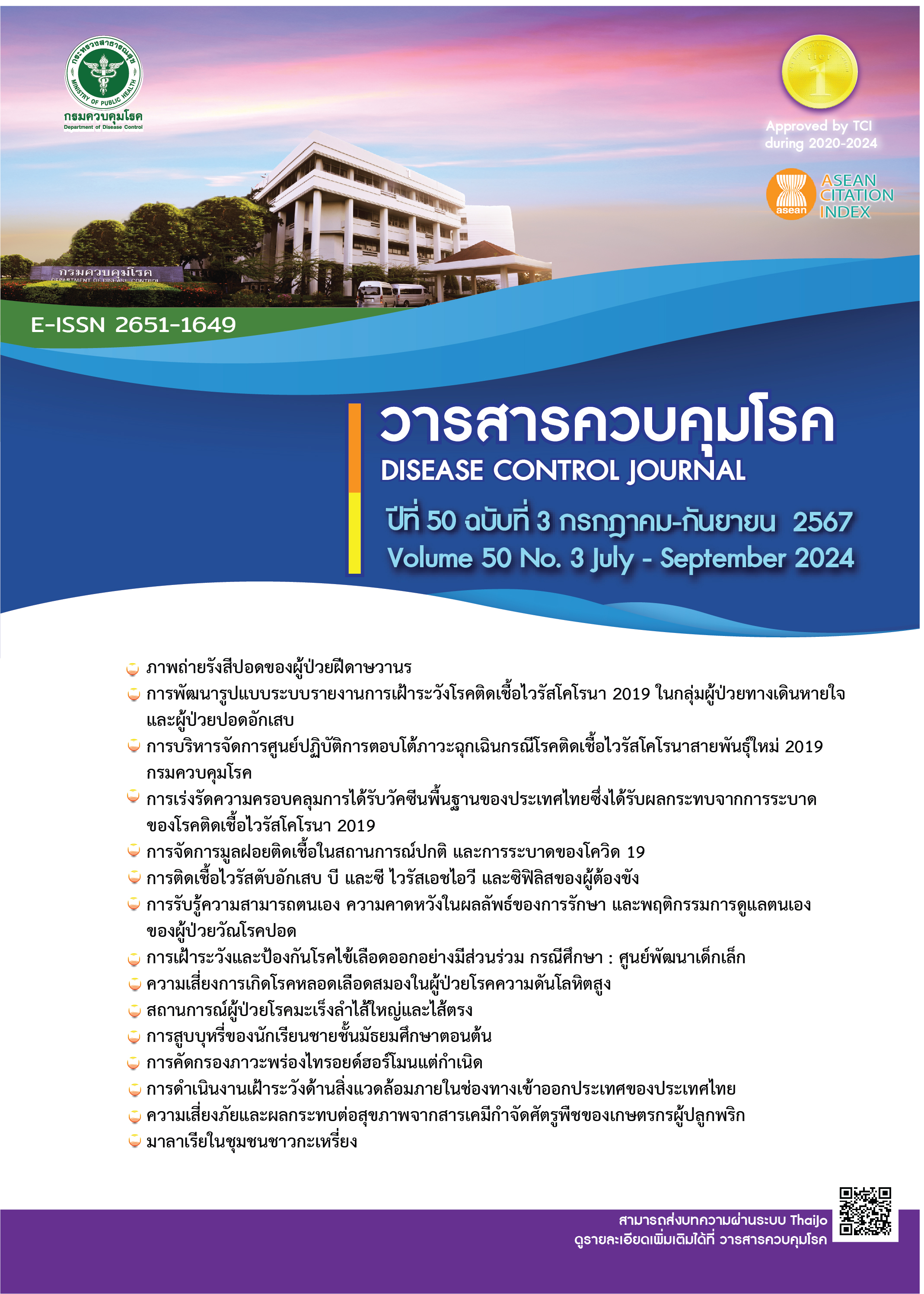Factors related to smoking behaviors among male secondary school students: A school case study from Tha-it Sub-district, Pakkret District, Nonthaburi Province, Thailand
DOI:
https://doi.org/10.14456/dcj.2024.32Keywords:
male secondary school students, predisposing factors, enabling factors, reinforcing factors, smoking behaviorAbstract
The aim of this cross-sectional descriptive study was to determine smoking behavior and the related factors among male secondary school students at a school in Tha-it sub-district, Pakkret district, Nonthaburi province. Samples were collected by two-stage sampling method and 105 male students were recruited. Data collection was done from November to December 2023. Data were collected by using self-administered questionnaire: predisposing factors including general information, smoking behavior, and attitude for smoking behavior; enabling factors including accessibility of smoking prevention; and reinforcing factors with social support from family and school for smoking prevention. Descriptive statistics and binary logistic regression analysis were used for data analysis. The result found that 32.4% of the samples had ever tried to smoke (24.8%) and smoke currently (7.6%). The factors related to smoking behavior among male secondary school students were predisposing factors including their level of studying (p-value=0.021). smoking among family members (p-value=0.002) and having friends who smoke (p-value=<0.001. Male students studying in Mathayom 1 and Mathayom 2 had a higher risk of smoking than those in Mathayom 3 5.05 and 3.55 times (95% CI: 1.59-16.07 and 1.10-11.41, respectively). Male students whose family members smoke have a 3.85 times risk of engaging in smoking (95% CI: 1.63-9.08) than those without family members smoke, having friends in a group who smoke has a 6.61 times greater risk of smoking (95% CI: 2.64-16.54) than those without friends who smoke in a group. These findings suggest that the skills on reject smoking should be introduced among students to prevent smoking initiation and the non-smoking behavior campaigns should be implemented from primary school. A counseling program should be established for students who smoke. Developing and raising standards for smoke-free schools and a participatory smoke-free community are also suggested
Downloads
References
Thaihealth. Smoking behavior increases risk of contracting COVID-19 14 times [Internet]. [cited 2024 Jan 5]. Available from: https://www.thaihealth.or.th/?p=220332 (in Thai)
World Health Organization. Tobacco [Internet]. [cited 2024 Jan 5]. Available from: https://www.who.int/health-topics/Tobacco
Thaihealth. Reveal the results of the survey on smoking behavior of the national statistical office in 2021 [Internet]. [cited 2024 Jan 6]. Available from: https://www.thaihealth.orth/?p=264104 (in Thai)
National Statistical Office (TH). Summary of important results survey of smoking and drinking behavior of the Thai population 2014 [Internet]. [cited 2024 Jan 6]. Available from: https://www.nso.go.th/nsoweb/storage/ebook/2023/20230509202217_14104.pdf(in Thai)
Chidnayee S, Yottavee W. Factors related with smoking behaviors of youth at Uttaradit. BCNUT J Nurs 2021;10:83-92. (in Thai)
Vutiso P, Phattharasirisomboon P, Rodrungsee B. Factors predicting smoking behavior among adolescents at Mueang District in Chaiyaphum Province. TJN 2022;71:1-9. (in Thai)
Green LW, Kreuter MW. Health promotion planning: an educational and ecological approach (3rd ed). Mountain View, CA: Mayfield; 1999.
Luksanavimon L, Petsirasan R, Aekwarangkoon S, Noonil N. Factors related to smoking behavior among youths in Thasala District, Nakhon Si Thammarat Province. TJN 2020;69:1-9. (in Thai)
Kantaapa T. Factors related with smoking of late elementary students in opportunity expansion schools at Kham Muang District, Kalasin Province. JDPC7KK 2021;28:41-52. (in Thai)
Jankaew J, Homsin P, Srisuriyawet R. Factors related to smoking initiation among male students in lower secondary schools, Pathum Tani. JNSCU 2015;27:99-110. (in Thai)
Tanthanapanyakorn P, Wongpituk K, Saykaew T, Chankong W. Factors associated with smoking behavior of youth in Lat Yai Sub district Mueang Samut-Songkhram District Samut Songkhram Province. AJCPH 2021;7:59-72. (in Thai)
Lhekkan S, Dallas JC, Vatanasin D. Predictive factors of smoking avoidance behaviors among male students of extended educational opportunity schools. JFONUBUU 2022;30:13-27. (in Thai)
Nonthaburi Provincial Office. Summary of Nonthaburi Province [Internet]. [cited 2024 Mar 18]. Available from: https://www.nonthaburi.go.th/Downloads/brief_nonthaburi.pdf (in Thai)
Jirawatkul A. Statistics for health science research. 4th ed. Bangkok: Wittayapat; 2015. (inThai)
Best JW. Research in education (3rd ed). New Jersey: Prentice-Hall; 1977.
Bloom BS. Taxonomy of education. New York: Mc Graw-Hill Book; 1975.
Department of Disease Control (TH). Legal regulations for cigarette sellers [Internet]. [cited 2024 Mar 18]. Available from: https://ddc.moph.go.th/law.php?law=2 (in Thai)
Aekwarangkoon S, Kongkamned R, Sindhu S, Luksanavimon L. Sexual health services for youths: Situation, challenge, and guide for action. TJN 2016;65:16-23. (in Thai)
TRC Data Center. Report on tobacco consumption statistics in Thailand 2018. Bangkok: TRC Data Center; 2018. (in Thai)
Stoll K. Correlates and predictors of tobacco use among immigrant and refugee youth in a Western Canadian city. J Immigr Minor Health 2008;10:567-74.
Downloads
Published
How to Cite
Issue
Section
License
Copyright (c) 2024 Disease Control Journal

This work is licensed under a Creative Commons Attribution-NonCommercial-NoDerivatives 4.0 International License.
Articles published in the Disease Control Journal are considered as academic work, research or analysis of the personal opinion of the authors, not the opinion of the Thailand Department of Disease Control or editorial team. The authors must be responsible for their articles.






